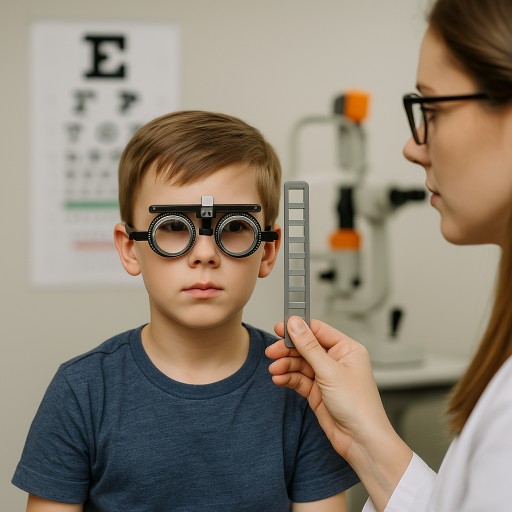Convergence Insufficiency in Kids – Vision Guide
Key Takeaways: Protecting Your Child’s Vision from Convergence Insufficiency (CI)
-
CI is Common but Often Missed: Over 17% of Seattle children show signs of Convergence Insufficiency—yet it’s frequently misdiagnosed as a learning issue due to misleading symptoms like blurred text or trouble concentrating.
-
20/20 Isn’t Enough: Traditional eye exams and school screenings test clarity, not eye coordination. Your child can pass with “perfect” vision while still struggling with CI.
-
Screen Time Is a Major Culprit: Excessive use of tablets and virtual learning tools is rapidly increasing CI cases. Near-constant close focus fatigues young eyes and disrupts normal development.
-
Know the Warning Signs: Watch for headaches after reading, double vision, avoiding homework, or one-eye squinting—especially if your child reads well but struggles to stay focused.
-
Demand Specialized Testing: Seattle parents should request convergence and binocular vision testing—not just basic eye charts—especially if your child has unexplained reading or attention difficulties.
-
Treatments Work—Without Surgery: Vision therapy and at-home exercises like pencil push-ups can dramatically improve symptoms, with 75–80% success rates reported in clinical studies.
-
Daily Habits Make a Difference: Enforce screen time limits, follow the 20-20-20 rule, and encourage outdoor play to relax and strengthen your child’s visual system.

1. The Overlooked Childhood Vision Disorder: Convergence Insufficiency (CI)
Why Seattle Parents Should Prioritize Specialized Testing
Convergence insufficiency (CI) affects how children’s eyes team for near tasks like reading—and it’s surprisingly common. Seattle eye exams across two major clinics revealed that 17.6% of tested children had CI. Alarmingly, symptoms often mimic learning disabilities (e.g., text blurring during homework), leading to misdiagnosis.
2. What Exactly Is Convergence Insufficiency?
The Eye Teamwork Breakdown Explained Simply
Imagine your eyes as binoculars fail to align. That’s CI: an eye coordination disorder where eyes drift outward instead of pivoting inward (converging) for close focus. Seattle optometrists stress this isn’t about visual clarity—it’s about how eyes collaborate for books, screens, or crafts. Result? Double vision, eye strain, and frustrating concentration lapses.
3. Spotting CI Symptoms: Red Flags for Seattle Families
When Reading Struggles Signal Vision Problems
Suspect CI if your child shows these signs during homework or screen time:
-
Headaches behind the eyes after 10+ minutes of reading
-
Words “swimming” or blurring on pages
-
Double vision or excessive eye fatigue
-
Squinting/covering one eye for focus
-
Avoiding reading despite strong comprehension skills
4. Why CI Gets Missed (and How Seattle Experts Diagnose It)
The Critical Limits of Basic Vision Screenings
Standard eye charts (like school screenings) test clarity—not eye teamwork. Your child could have 20/20 vision yet undiagnosed CI! Seattle eye doctors use a 3-step diagnostic process:
-
Symptom Analysis: Detailed discussion of reading challenges.
-
Vision Assessment: Ruling out nearsightedness/astigmatism.
-
Convergence Testing: Prism lenses or “pencil push-ups” (tracking a near object to the nose).
5. The Screen Time Crisis: Fueling CI in Seattle’s Children
Seattle parents, take note: Digital screens are accelerating convergence insufficiency (CI) cases in local children. CI disrupts eye coordination for near tasks, causing headaches, double vision, and eye strain.
Critical findings from Wills Eye Hospital:
-
50%+ of online learners (ages 10-17) report CI symptoms
-
17% developed severe CI directly linked to screen overuse
-
Tablets/smartphones demand non-stop eye convergence, exhausting young visual muscles
Seattle eye doctors confirm: Virtual learning = vision strain epidemic
6. 4 Ways Screens Sabotage Young Eyes
Seattle children’s screen habits strain eyes through:
-
Non-Stop Near Focus
Screens force relentless convergence – eyes locked inward without rest -
Blinking Blackout
Screen hypnosis cuts blinking by 60%, drying eyes and amplifying strain -
Break Deficit
Online marathons skip natural pauses that reset the focus -
Tunnel Vision Trap
Fixed gaze stiffens eye muscles, crippling flexible focus shifts
7. Seattle’s Action Plan: Shielding Young Eyes from CI
Protect young vision with these essential steps:
-
Enforce Smart Screen Limits
Follow AAP guidelines: <2 hours/day of recreational use for kids over 5 -
Practice the 20-20-20 Rule Religiously
Every 20 minutes, gaze 20 feet away for 20 seconds (set phone reminders!) -
Prioritize Green Time Over Screen Time
Daily outdoor play relaxes convergence muscles – Discovery Park is perfect for visual resets. -
Demand Advanced Eye Exams
Basic screenings miss CI. Seattle parents: insist on binocular vision testing
8. The 20/20 Blind Spot: Why Standard Tests Fail Seattle Kids
Seattle parents, beware: A 20/20 score doesn’t guarantee healthy vision. Standard eye charts only test clarity—not how eyes coordinate for reading or screens. Convergence insufficiency (CI) is a binocular vision disorder that disrupts eye teamwork, not sharpness. Seattle eye doctors stress: basic school screenings miss CI 90% of the time.
9. 4 Advanced Tests That Unmask Hidden CI
Seattle vision specialists rely on these gold-standard CI diagnostics:
-
Near Point of Convergence (NPC)
Measures how close an object can get before eyes lose focus teamwork (receded = CI red flag). -
Prism Testing
Lenses assess eye alignment strength and fusion ability under stress. -
Symptom Surveys
Validated questionnaires track reading headaches, double vision, and focus lapses. -
Cover Test
Detects subtle misalignment by observing uncovered eye movements.
10. The 3-Step CI Diagnostic Process in Seattle Clinics
Seattle’s thorough CI exams involve:
-
Step 1: Symptom Deep Dive
Discussing screen/reading struggles, headaches, and concentration drops. -
Step 2: Visual Acuity Confirmation
Verifying 20/20 clarity to rule out refractive errors. -
Step 3: Binocular Stress Test
Evaluating eye teaming, focusing stamina, and tracking under near-stress conditions.
11. Research-Backed CI Treatments: Seattle’s Non-Surgical Solutions
Seattle parents celebrate: Convergence insufficiency (CI) responds exceptionally well to non-surgical treatments, especially with early intervention. Seattle vision therapy specialists achieve success through:
-
Vision Therapy: Customized eye exercises that rebuild coordination—studies show 80% symptom reduction and reading fluency gains.
-
Pencil Push-Ups: Daily 5-minute home training (tracking a pencil to the nose) to strengthen convergence muscles.
-
Prism Glasses: Temporary lenses aligning images during screen time or homework.
-
Lifestyle Optimization: Enforcing screen breaks + outdoor play to prevent regression.
12. Vision Therapy: The Gold Standard for Lasting CI Improvement
Clinical trials overwhelmingly confirm that structured vision therapy delivers the most significant, lasting CI relief. Key insights from the research:
-
12-week programs show 75% success rates (CITT Study)
-
Combines in-office tech (computer orthoptics) with home reinforcement
-
Seattle clinics report higher compliance with gamified exercises
Critical factor: 3x/week supervised sessions + daily home practice prevent relapse.
FAQs
-
What is convergence insufficiency and how does it affect my eyes?
Convergence insufficiency is when your eyes don’t work well together up close, causing double vision, eye strain, or headaches during reading or screen use.
-
How can I tell if my child has convergence insufficiency?
-
How do eye doctors diagnose convergence insufficiency?
-
What treatments are effective for convergence insufficiency?
-
Can convergence insufficiency cause learning difficulties in children?
-
Is convergence insufficiency permanent or can it be cured?
-
Can brain injuries cause convergence insufficiency?
-
Why do my eyes feel tired or blurry when reading?
-
How long does vision therapy take to improve convergence insufficiency?
-
Can prism glasses fix convergence insufficiency?
-
Are there any exercises I can do at home for convergence insufficiency?
-
Should I get my child’s eyes tested if they avoid reading?



